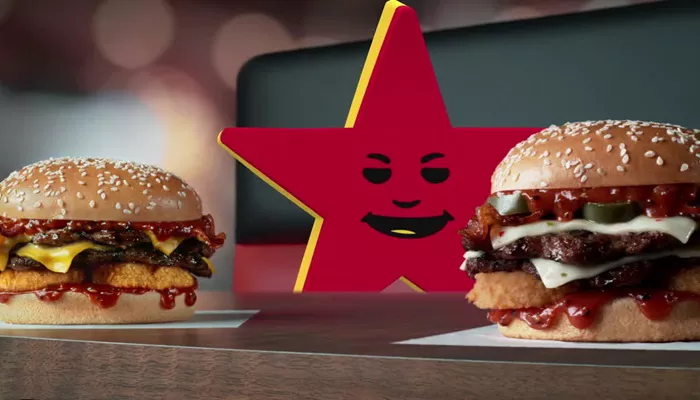Carl’s Jr. is a prominent fast-food chain that has carved out a unique niche in the competitive landscape of quick-service restaurants (QSRs). Founded in 1941 by Carl N. Karcher and his wife Margaret, the brand began as a humble hot dog cart in Los Angeles and has since evolved into a global sensation known for its bold flavors and innovative menu items. Unlike many of its competitors, Carl’s Jr. focuses on delivering high-quality, charbroiled burgers and a diverse array of offerings that appeal to adventurous eaters. This article explores what makes Carl’s Jr. distinct from other fast-food chains, examining its history, menu innovation, marketing strategies, and commitment to quality.
A Rich History
Carl Karcher started his journey in the food industry with just $15 in savings and a loan against his car. His initial success with hot dog stands led to the opening of the first Carl’s Drive-In Barbecue in Anaheim in 1945. This restaurant expanded the menu to include hamburgers, setting the stage for what would become Carl’s Jr..
Evolution of The Brand
The name “Carl’s Jr.” was coined in 1956 when Karcher introduced smaller versions of his restaurants to cater to the growing demand for fast food. The “Jr.” signifies these express versions, which provided quick service without compromising on quality. This innovative approach helped establish Carl’s Jr. as one of the pioneers of the fast-food industry.
Unique Menu Offerings
Charbroiled Burgers
One of the standout features of Carl’s Jr. is its emphasis on charbroiled burgers. The chain prides itself on using 100% Angus beef patties, which are cooked over an open flame to enhance flavor. This method not only differentiates their burgers from competitors but also aligns with consumer preferences for grilled meats.
SEE ALSO: The 7 Major Countries with KFC Franchises
Innovative Products
Carl’s Jr. is known for its willingness to experiment with bold flavors and unique ingredients. The chain has introduced several innovative items over the years, such as:
Beyond Famous Star: In 2019, Carl’s Jr. became the first major QSR to offer a plant-based burger nationwide by partnering with Beyond Meat, catering to the growing demand for meat alternatives.
Spicy Western Bacon Cheeseburger: This burger combines crispy onion rings and BBQ sauce with charbroiled beef, showcasing Carl’s Jr.’s flair for combining flavors.
Ghost Pepper Burger: This item reflects the brand’s commitment to pushing culinary boundaries by incorporating spicy ingredients that appeal to thrill-seeking customers.
Value Menus
In response to economic pressures and changing consumer preferences, Carl’s Jr. has introduced value menus that maintain quality while offering affordability. The “More Bang, Less Buck” menu features items priced under $4, ensuring that customers can enjoy delicious food without overspending.
Marketing Strategies
Bold Advertising Campaigns
Carl’s Jr. is recognized for its provocative advertising campaigns that often feature celebrity endorsements and edgy themes.
These advertisements are designed to attract a younger demographic looking for excitement and adventure in their dining experiences. The brand has successfully used humor and shock value to create memorable marketing moments that resonate with consumers.
Social Media Engagement
In today’s digital age, Carl’s Jr. has effectively leveraged social media platforms to engage with its audience. The brand uses visually appealing content and interactive campaigns to connect with customers, promoting new menu items and encouraging user-generated content. This approach not only enhances brand visibility but also fosters a sense of community among fans.
Commitment to Quality
Sourcing Ingredients
Carl’s Jr. places a strong emphasis on sourcing high-quality ingredients for its menu items. The chain prioritizes fresh produce and premium meats, ensuring that every burger is crafted with care and attention to detail. This commitment to quality sets Carl’s Jr. apart from many other fast-food chains that may rely on frozen or processed ingredients.
Customer Experience
The dining experience at Carl’s Jr. is designed to reflect its California roots, emphasizing a laid-back atmosphere where customers can enjoy their meals in comfort. The chain’s restaurants often feature modern designs and inviting spaces that enhance the overall dining experience.
Conclusion
Carl’s Jr. stands out in the crowded fast-food market due to its rich history, innovative menu offerings, bold marketing strategies, and unwavering commitment to quality. By focusing on charbroiled burgers made from premium ingredients and engaging customers through provocative advertising and social media, Carl’s Jr. has successfully established itself as a leader in the quick-service restaurant industry.
As consumers continue to seek out unique dining experiences that prioritize flavor and quality, Carl’s Jr.’s distinctive approach positions it well within the competitive landscape of fast food. Whether through its adventurous menu items or its engaging marketing campaigns, Carl’s Jr. remains a brand that resonates with those who crave bold flavors and high-quality meals at an accessible price point.
In summary, Carl’s Jr.’s dedication to innovation and quality makes it a unique player among fast-food chains, appealing particularly to those who appreciate flavorful options served with flair.

